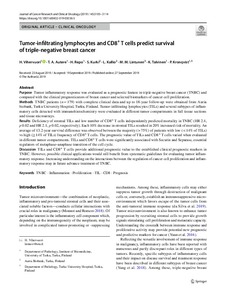Tumor-infiltrating lymphocytes and CD8+ T cells predict survival of triple-negative breast cancer
Pauliina Kronqvist; Samu Kurki; Hilda Vihervuori; Tuomo-Artturi Autere; Heli Repo; Lila Kallio; Kati Talvinen; Minnamaija Lintunen
https://urn.fi/URN:NBN:fi-fe2021042822589
Tiivistelmä
Purpose
Tumor inflammatory response was evaluated as a prognostic feature in triple-negative breast cancer (TNBC) and compared with the clinical prognosticators of breast cancer and selected biomarkers of cancer cell proliferation.
Methods
TNBC patients (n = 179) with complete clinical data and up to 18-year follow-up were obtained from Auria biobank, Turku University Hospital, Turku, Finland. Tumor-infiltrating lymphocytes (TILs) and several subtypes of inflammatory cells detected with immunohistochemistry were evaluated in different tumor compartments in full tissue sections and tissue microarrays.
Results
Deficiency of stromal TILs and low number of CD8+ T cells independently predicted mortality in TNBC (HR 2.4, p 0.02 and HR 2.1, p 0.02, respectively). Each 10% decrease in stromal TILs resulted in 20% increased risk of mortality. An average of 13.2-year survival difference was observed between the majority (> 75%) of patients with low (< 14% of TILs) vs high (≥ 14% of TILs) frequency of CD8+ T cells. The prognostic value of TILs and CD8+ T cells varied when evaluated in different tumor compartments. TILs and CD8+ T cells were significantly associated with Securin and Separase, essential regulators of metaphase–anaphase transition of the cell cycle.
Discussion
TILs and CD8+ T cells provide additional prognostic value to the established clinical prognostic markers in TNBC. However, possible clinical applications would still benefit from systematic guidelines for evaluating tumor inflammatory response. Increasing understanding on the interactions between the regulation of cancer cell proliferation and inflammatory response may in future advance treatment of TNBC.
Kokoelmat
- Rinnakkaistallenteet [19207]
